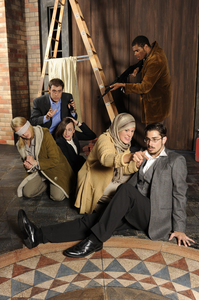U-M's 'Pentecost' starts slow, but has a satisfying payoff

Cast members from U-M's production of David Edgar's "Pentecost."
photo by Peter Smith Photography
I remember feeling terribly sad a decade ago, when I learned of the deliberate destruction of two enormous Buddha statues that had been carved into the side of a cliff in Afghanistan during the 6th century. (The Taliban considered them to be “idols” and consequently blew them up.)
At the time, I opined that works of art should earn a special, sacred status worldwide on the basis of their historical value, and thus be exempt from political/religious/ethnic violence. A nice idea, surely, but wildly naïve, in the sense that works of art — particularly those that exist as part of the natural landscape — never exist in a vacuum, and always have cultural baggage (to be either abused or revered) attached.
David Edgar’s “Pentecost,” now being staged by the University of Michigan’s department of theater, raises and expands on this topic. Set in an old church in Eastern Europe in the 1990s, the play begins when a curator, Gabriella (Emily Berman) invites art historian Oliver (Joey Richter) to see a fresco that she believes may have great historical significance. Religious and political figures keep a close eye on their progress, and American art historian Leo Katz (Reed Campbell) shows up to de-bunk the pair’s theory.
But everything comes to a stop when an eclectic group of refugees — each of whom are seeking asylum in one country or another — arrives at the church and takes the curator and historians hostage.
The two-and-a-half-hour play’s first half is dedicated to revealing the fresco’s mysteries (raising the issue of restoration vs. preservation along the way), while the second act focuses on the refugees and their plight. And although “Pentecost”’s first act offered several thought-provoking discussions, I didn’t feel emotionally invested at all until the second act.
For not only do we then hear the refugees’ often-tragic back-stories, but we also — despite language barriers (hence the play’s title) — see them communicating with each other and the three hostages by way of music, storytelling, pop culture references, and jokes. Stripped down to basic humanity, the group starts to jell, temporarily erasing the power structure that gave birth to their current circumstances. So by the time the play reached its boiling point on opening night, I was all in.
Yes, the production suffers a bit because all the performers look so young. But the actors handle the various dialects impressively well (thanks partly to dialect coach Annette Masson), and director Malcolm Tulip expertly guides the large ensemble.
In the first act on opening night, Richter and Campbell were solid, but Berman was the standout, depicting a woman who’s striving to provide her politically dissembled country with an identity, a privileged place in art history, and thus a respected name in the world. Myles Mershman was eerily spot-on as the charismatic minister of culture, meanwhile; and in the second act, several performers playing refugees (Alli Brown, Jesse Peri, Paul Koch, and particularly Elly Jarvis) got a few opportunities to shine.
Marguerite Woodward’s set design is stunning, economically capturing the look and feel of an old church’s interior (complete with sections of “brick” that can be pulled out to reveal the fresco). Corey Lubowich’s costumes were generally well-done (with the curious exception of a heavily-padded policewoman, which drew giggles from the opening night crowd); and Adam McCarthy’s lighting was subtly affecting.
But if you go, don’t expect fireworks from the get-go. Edgar’s piece is more of a slow-burn that builds to a theatrical climax you won’t soon forget.
Jenn McKee is the entertainment digital journalist for AnnArbor.com. Reach her at jennmckee@annarbor.com or 734-623-2546, and follow her on Twitter @jennmckee.

